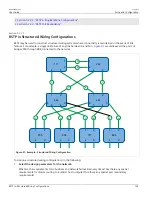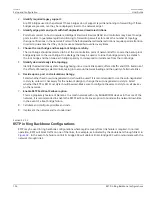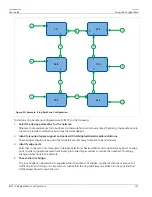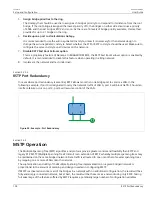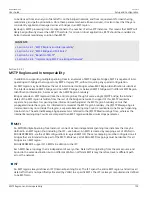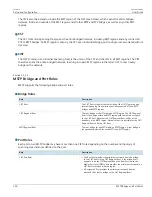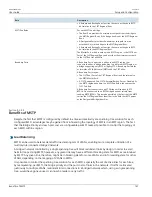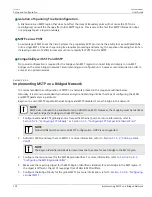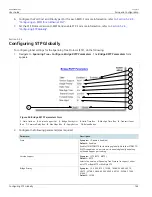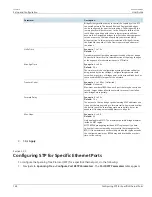
RUGGEDCOM ROS
User Guide
Chapter 5
Setup and Configuration
RSTP States and Roles
149
it requires that frame transfer halt after a link outage until all bridges in the network are guaranteed to be aware
of the new topology. Using the values recommended by 802.1D, this period lasts 30 seconds.
The Rapid Spanning Tree Protocol (RSTP, IEEE 802.1w) was a further evolution of the 802.1D Spanning Tree
Protocol. It replaced the settling period with an active handshake between bridges that guarantees the rapid
propagation of topology information throughout the network. RSTP also offers a number of other significant
innovations, including:
• Topology changes in RSTP can originate from and be acted upon by any designated bridges, leading to more
rapid propagation of address information, unlike topology changes in STP, which must be passed to the root
bridge before they can be propagated to the network.
• RSTP explicitly recognizes two blocking roles - Alternate and Backup Port - which are included in computations
of when to learn and forward. STP, however, recognizes only one state - Blocking - for ports that should not
forward.
• RSTP bridges generate their own configuration messages, even if they fail to receive any from the root bridge.
This leads to quicker failure detection. STP, by contrast, must relay configuration messages received on the root
port out its designated ports. If an STP bridge fails to receive a message from its neighbor, it cannot be sure
where along the path to the root a failure occurred.
• RSTP offers edge port recognition, allowing ports at the edge of the network to forward frames immediately
after activation, while at the same time protecting them against loops.
While providing much better performance than STP, IEEE 802.1w RSTP still required up to several seconds to
restore network connectivity when a topology change occurred.
A revised and highly optimized RSTP version was defined in the IEEE standard 802.1D-2004 edition. IEEE
802.1D-2004 RSTP reduces network recovery times to just milliseconds and optimizes RSTP operation for various
scenarios.
RUGGEDCOM ROS supports IEEE 802.1D-2004 RSTP.
CONTENTS
•
Section 5.2.1.1, “RSTP States and Roles”
•
•
Section 5.2.1.3, “Point-to-Point and Multipoint Links”
•
Section 5.2.1.4, “Path and Port Costs”
•
Section 5.2.1.5, “Bridge Diameter”
•
•
Section 5.2.1.7, “Fast Root Failover”
Section 5.2.1.1
RSTP States and Roles
RSTP bridges have roles to play, either root or designated. One bridge - the Root Bridge - is the logical center of
the network. All other bridges in the network are Designated bridges. RSTP also assigns each port of the bridge a
state and a role. The RSTP state describes what is happening at the port in relation to address learning and frame
forwarding. The RSTP role basically describes whether the port is facing the center or the edges of the network
and whether it can currently be used.





















